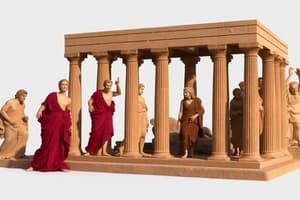Podcast
Questions and Answers
What was the primary influence on Roman Theatre?
What was the primary influence on Roman Theatre?
- Greek theatre (correct)
- Renaissance theatre
- Medieval mystery plays
- Christian morality plays
Who is considered the father of tragedy?
Who is considered the father of tragedy?
- Plautus
- Euripides
- Sophocles
- Aeschylus (correct)
What was a characteristic of Renaissance theatre architecture?
What was a characteristic of Renaissance theatre architecture?
- Portable stages and scenery
- Outdoor amphitheatres
- Proscenium arch and picture frame stage
- Indoor playhouses with thrust stages (correct)
Who was the first female playwright?
Who was the first female playwright?
What was a characteristic of Ancient Greek theatre?
What was a characteristic of Ancient Greek theatre?
What was a characteristic of 20th century theatre architecture?
What was a characteristic of 20th century theatre architecture?
Who was a notable playwright of the Renaissance?
Who was a notable playwright of the Renaissance?
What type of plays were popular during the Medieval period?
What type of plays were popular during the Medieval period?
Flashcards are hidden until you start studying
Study Notes
Ancient Greece (6th - 4th century BCE)
- Birthplace of Western theatre
- Theatre originated from religious festivals honoring Dionysus
- Playwrights:
- Aeschylus (father of tragedy)
- Sophocles
- Euripides
- Notable plays:
- "The Persians" by Aeschylus (first surviving Greek tragedy)
- "Oedipus Rex" by Sophocles
- Theatre architecture:
- Outdoor amphitheatres with stone seats
- Orchestra (performance area) and skene (backstage)
Roman Theatre (1st century BCE - 5th century CE)
- Influenced by Greek theatre
- Popular entertainment for the masses
- Theatre architecture:
- Large, ornate buildings with elaborate decorations
- Permanent stages and scenery
- Playwrights:
- Plautus (comedy)
- Terence (comedy)
Medieval Theatre (5th - 15th century)
- Christian morality plays and mystery plays
- Performed in churches, courtyards, and town squares
- Playwrights:
- Hildegard of Bingen (first female playwright)
- Theatre architecture:
- Portable stages and scenery
- Use of masks and pageantry
Renaissance Theatre (16th - 17th century)
- Revival of classical Greek and Roman theatre
- Emergence of professional theatre companies
- Playwrights:
- William Shakespeare (England)
- Molière (France)
- Theatre architecture:
- Indoor playhouses with thrust stages
- Use of scenery and special effects
18th and 19th Centuries
- Neoclassicism and Romanticism
- Rise of melodrama and vaudeville
- Playwrights:
- Henrik Ibsen (Norway)
- Oscar Wilde (Ireland)
- Theatre architecture:
- Proscenium arch and picture frame stage
- Use of gaslights and later electricity
20th Century
- Experimental and avant-garde movements
- Rise of realism and naturalism
- Playwrights:
- Bertolt Brecht (Germany)
- Samuel Beckett (Ireland)
- Theatre architecture:
- Black box and flexible seating
- Use of multimedia and technology
Ancient Greece (6th - 4th century BCE)
- Western theatre originated in Ancient Greece as part of religious festivals honoring Dionysus
- Aeschylus, Sophocles, and Euripides were prominent playwrights of the time
- Notable plays include "The Persians" by Aeschylus, the first surviving Greek tragedy, and "Oedipus Rex" by Sophocles
- Theatre architecture featured outdoor amphitheatres with stone seats, an orchestra (performance area), and a skene (backstage)
Roman Theatre (1st century BCE - 5th century CE)
- Roman theatre was heavily influenced by Greek theatre
- Theatre was a popular form of mass entertainment
- Large, ornate buildings with elaborate decorations and permanent stages and scenery were characteristic of Roman theatre architecture
- Playwrights like Plautus and Terence wrote comedies during this period
Medieval Theatre (5th - 15th century)
- Christian morality plays and mystery plays dominated this period
- Performances took place in churches, courtyards, and town squares
- Hildegard of Bingen was the first female playwright
- Theatre architecture featured portable stages and scenery, with the use of masks and pageantry
Renaissance Theatre (16th - 17th century)
- There was a revival of classical Greek and Roman theatre during the Renaissance
- Professional theatre companies emerged, and playwrights like William Shakespeare and Molière wrote influential works
- Indoor playhouses with thrust stages and the use of scenery and special effects characterized Renaissance theatre architecture
18th and 19th Centuries
- Neoclassicism and Romanticism influenced theatre during this period
- Melodrama and vaudeville became popular forms of entertainment
- Playwrights like Henrik Ibsen and Oscar Wilde made significant contributions
- Theatre architecture featured the proscenium arch and picture frame stage, with the use of gaslights and later electricity
20th Century
- Experimental and avant-garde movements emerged in 20th-century theatre
- Realism and naturalism became popular styles
- Playwrights like Bertolt Brecht and Samuel Beckett wrote influential works
- Theatre architecture featured black box and flexible seating, with the use of multimedia and technology
Studying That Suits You
Use AI to generate personalized quizzes and flashcards to suit your learning preferences.




